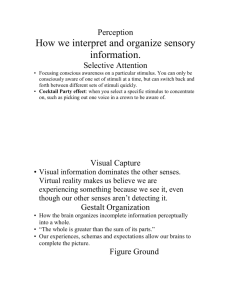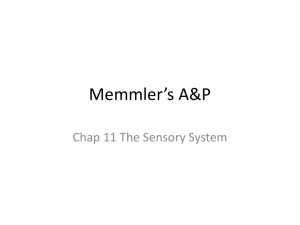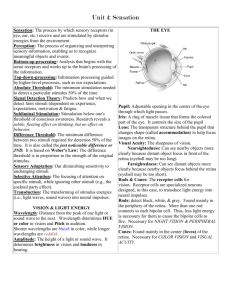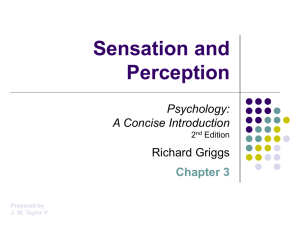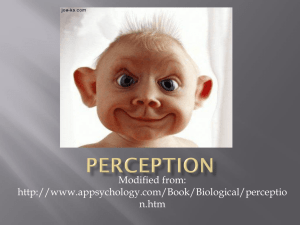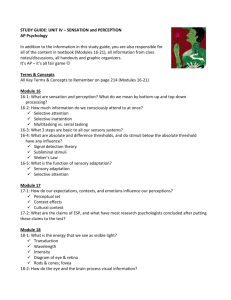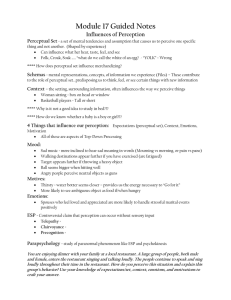Sensation and Perception
advertisement
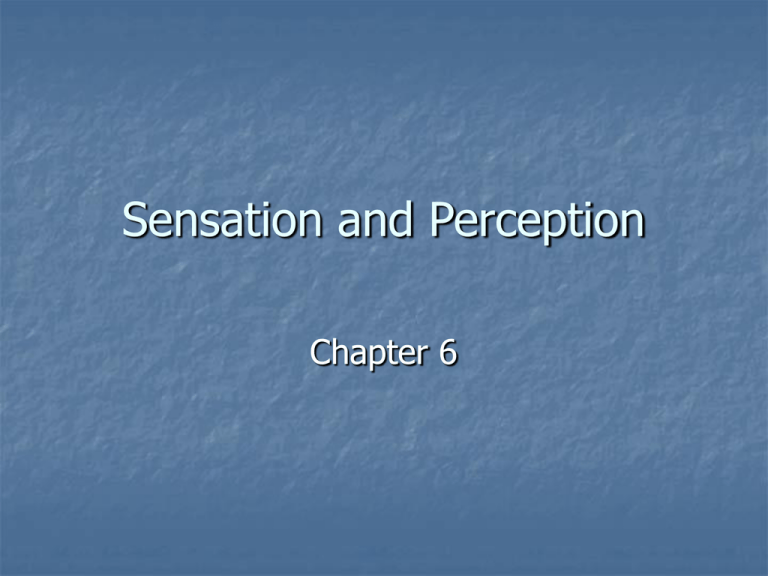
Sensation and Perception Chapter 6 Sensation Detection of physical energy from the environment which we encode as neural signals Perception Organize and interpret our sensations Bottom- up processing Beginning level of sensory analysis. Bottom up processing- is sensory analysis that begins at the entry level, with information flowing from the sensory analysis that begins at the entry level with information flowing from the sensory receptors to the brain Top-down processing The information processing guided by higher-level mental processes, as when someone constructs perceptions drawing on our experience and expectations. Prosopagnosia Faceblindness the inability to recognize and connect the outside the world. Complete sensation was present but perception was incomplete. It is the lack of top-down processing Psychophysics The study of relationships between the physical characteristics of stimuli, such as their intensity, and our psychological experience of them. Thresholds Absolute threshold is the minimum stimulation needed to detect a particular stimulus 50 percent of the time A hearing specialist would expose an individual to varying sounds in order to figure out their absolute threshold Thresholds Signal detection theory is the theory which predicts how and when we detect the presence of a faint stimulus amidst background stimulation. Assuming that there is no single absolute threshold and the detection depends partly on a person’s experience, expectations, motivation and level of fatigue. A person’s heightened attention decreases after 30 minutes. Sensory Adaptation of the eye. Notice that the images disappear and reappear as the eye moves. Thresholds More false alarms are detected in heightened responsiveness A stimulus is Subliminal if it is below your absolute threshold, you detect it less than 50% of the time. For instance, a microscopic cell is subliminal to you because you cannot see it with your naked eye. Subliminal advertisements (Drink Coke, eat popcorn etc.), does have an affect on you but do not persuade you. The final statement of subliminal messages could be that much of our information processing occurs automatically, out of sight, off the radar screen of our conscious mind. Thresholds The Difference Threshold (just noticeable difference or ”jnd”) is the lowest difference you can detect between the two stimuli 50% of the time. For example, let's say I asked you to put your hand out and in it I placed a pile of sand. Then, I add tiny amounts of sand to your hand and ask you to tell me when you notice any change in the overall weight. As soon as you can detect any change in the weight, that difference between the weight of the sand before I added that last bit of sand and the amount of sand after I added it, is the difference threshold. . Priming is an acuteness to stimuli because of exposure to a certain event or experience. For example, an individual who has just purchased a new car may now start to notice with more frequency other people driving her same make and model. This person has been primed to recognize more readily a car like hers because of the experience she has driving and owning one. Thresholds Weber’s Law states that two stimuli must differ in percentages or ratios, not amount, for a person to detect it (“jnd”). Example: if a waiter holding tray containing four glasses were just able to detect the added weight of one glass, he would just be able to feel the added weight from two more glasses if the tray already held eight glasses. The amount of detectable added weight would always be in the same proportion, in this case ¼. . Sensory Adaptation Sensory Adaptationlowered sensitivity due to constant exposure from stimulus. For example, when you go into someone’s house you notice an odor…but this only lasts for a little while because sensory adaptation allows you to focus your attention on changing environment. Sensory Adaptation If a constant image was maintained on the eye’s inner surface, the person will first see the complete image, then their sensory receptors will begin to fatigue and the image will start to vanish. The image will reappear and then disappear. This experiment reveals that perceptions are organized by the meanings that the mind imposes. This adaptation allows the person to focus on informative changes, leaving out uninformative constant stimulations. Vision Transduction refers to Sensory energy being convert (transformed) into Neural energy/impulses. Light is composed of electromagnetic waves with Wavelengths (distance from one peak to another peak on a wave) and Amplitudes (height of the wave) Wavelength determines hue and pitch determines the frequency in sound. Amplitude determines intensity and loudness in sound. External Light entering the eye first travels through the Cornea (protective layer) Pupil (an adjustable opening) is controlled by Iris (muscle around the pupil) Lens (an oval transparency) that changes shape to focus light by a process called accommodation. Spectrum of electromagnetic energy -this spectrum ranges from gamma rays as short as the diameter of an atom to radio waves over a mile long. The narrow band of wavelengths visible to the human eye extends form the shorter waves of the blue violet light to the longer waves of the red light Retina light is then focused onto the back of the eye called Retina (multi-neuron surface). Johannes Kepler revealed that the retinas did receive upside- down images. Researchers later revealed that the retina does not read the image as a whole, receptor cells convert light energy into neural impulses and these impulses then are sent to the brain, it is then that the image is constructed and perceived. Retina Acuity is how sharp and clear a vision is There are three basic types of Acuity : normal nearsightedness (only see near things clearly) farsightedness (only see far things clearly) The Retina has 2 types of receptor cells : Rods and Cones. Cells connecting these detectors form the Optic Nerve that sends the impulses to brain. Receptor cells are the specialized cells that respond to a particular type of energy. Rods are receptor cells in the retina responsible for night vision and perception of darkness. Retina Everyone has a Blind Spot, a small region in the visual field where nothing could be seen. This is because there are no receptor cells where the optic nerve leaves the eye in the retina. Normally, we don’t witness this effect because we have two eyes that compensate for each other’s blind spot, and the fact that our eyes are constantly moving. Retina Fovea is the region in the retina where light is centrally focused. The fovea has no rods, only cones. When light energy strikes the rods and cones, neural signals are generated. These signals activate the bipolar cells. The bipolar cells then activate the ganglion cells. They then form the optic nerve. Cones allow detail an color Cones allow one to perceive color. In the dark, the cone is ineffective. The rods are not affected by the dim light and many rods will focus their energy into one bipolar cell. Visual Information Processing The retina is brain tissue that floats to the eye during early fetal development There are three levels in which visual information is received. First, the retina processes information before sending it via the thalamus to the brain’s cortex. The retina also analyzes the sensory information Information from the retina is received and transmitted ganglion cells. Pressure can trigger the retina Visual Information Processing Nobel prize winners Hubel and Wiesel discovered Feature Detectors in the brain cortex that are sensitive to specific features in what we see ,like shape, color, depth, movement, and form. Perret identified nerve cells that specialize in responding to a specific gaze, head angle, posture. Parallel Processing Our brain Processes lots of information simultaneously. For example, looking at an orange, the brain processes the orange color, the round shape, and the bumpy texture all at the same time. People who cannot consciously perceive can still remarkably locate objects but are consciously unaware of how they knew. Such a phenomenon is called Blind Sight Parallel Processing The processing of many aspects of a problem simultaneously, the ban natural mode of information processing for many functions, including vision. Contrast with eh step by step (serial) processing of most computers and of conscious problem solving. Ex. Blindsightness Color Vision Young and von Helmholtz revealed that color can be created by combining the light waves of blue, red and green colors. They inferred that the eye must have three types of color receptors. Color processing is described in 2 stages : 1) Young-Helmholtz trichromatic (three-color) theory – Light is detected by 3 types of cones each specifically sensitive to Red, Blue, or Green. Combinations of them produce intermediate colors (yellow, cyan, purple) 2) Opponent-Process theory – Color is then processed by their opponent colors (red-green, blueyellow, black-white). Some cells are excited by blue and inhibited by yellow, vice versa. Thus, you cannot see a bluish-yellow. Hearing Hearing is highly adaptable Hearing Frequency (Pitch) is the number of waves traveling through a point in one second, relates to how fast a wave travels. Audition, or hearing, requires sounds waves converted into neural impulses, and this is done in the ear. Hearing Sound travels through the 3 sections of the ear to the brain : Outer ear : Auditory Canal Middle ear: Ear drum (tight membrane) . Concentrates the vibrations of the eardrum to the hammer, anvil, and stirrup to the cochlea’s oval window Inner ear : contains the Cochlea (coiled, fluidfilled tube) that contains the Basilar Membrane, which is lined with hair cells that vibrates to excite nerve fibers. The fibers form the Auditory Canal connecting to the brain. Loudness is determined by number of activated hair cells. Harder to hear sounds are amplified more than How do we perceive Pitch? Place theory says that we hear different pitches because specific “places” in the cochlea are stimulated. Frequency theory says that we hear different pitches because the speed of neural impulses traveling to the brain matches the speed of the sound waves (“frequency”). Does not explain how we hear low-pitched sounds, it can explain our sensation of high pitched sounds. It does explain our sensation of low-pitched sounds How do we locate sounds? We can tell which direction a sound is coming from because if it is closer to our right ear, the right ear will receive the sound slightly faster than left ear and the brain calculates this difference. If the sound is directly behind or in front, where the distance between two ears is the same, then it is difficult to differentiate. Sound waves strike one ear sooner and more intensely than the other. The ear uses parallel processing to analyze the differences in the sounds received by the two ears, and then finds the source. Hearing loss and Deaf Culture Conduction Deafness – loss of hearing due to damage of eardrum, and/or the tiny bones in middle ear. (Could be fixed by hearing aid) Sensorneural hearing loss- damage to the cochlea’s receptors. Destroys the receptors Shark and bird hair cells are able to regenerate. Cochlear Implants Cochlear Implants are the only way to restore hearing for people with nerve deafness These implants are wired to many sites on the auditory nerve, which allows them to transmit electrical impulses to the brain Most effective when the child is very young Deaf people argue against the implants since they do not view deafness as a disability, they also believe that the brain’s plasticity allows a greater strength in another area. Touch Touch is composed of 4 senses : Warmth, Pain, Cold, and Pressure Only pressure has specific receptors Pressure and Cold = wet Cold and warm = hot Pressure and Pain = tickling itch Pain Phantom Limb Sensations occur when pain is felt in a nonexistent limb. Even though the leg is not present, the receptor neurons previously connected to them are still there. And they will fire, resulting in pain sensations. Pain The Gate-Control Theory states that the spinal cord has “gates” that opens/closes to transmit pain impulses. Small fibers open Gate = pain. Large fibers close Gate = no pain Pain is merely a physical and psychological interpretation. Distraction methods, where attention is focused elsewhere, can ease the felt pain. Acupuncture (may affect gate-control), electrical stimulation, exercise can also relieve pain. The Biopschosocial perspective reveals that a person’s experience of pain is influenced by biological influences, past experiences and social cultural influences. Taste Taste is a Chemical Sense composed of 5 basics : Sweet, Sour, Salty, Bitter and Umami ( meaty taste) Taste receptors (taste buds) regenerate every 1 or 2 weeks, but age, smoking, and alcohol will lower taste bud number and sensitivity. Sensory Interaction is when one sense affects another sense, thus interacting. Smell and taste seem to interact. Taste buds on top and sides of the tongue and in the back and on the roof of the mouth contain taste receptor cells. The taster receptor cells send information to an area of the temporal lobe Smell Smell or Olfaction is also a Chemical Sense that directly transmits information from nose to the temporal lobe. The only sense that doesn’t first relay impulses to the Thalamus. The sense of smell- if you are to smell a flower, airborne molecules of its fragrance must reach receptors at the top of your nose. Sniffing swirls air up the receptors enhancing the aroma. The receptor cells send messages to the brain’s olfactory bulb, and then onward to the temporal lobe’s primary smell cortex and to the parts of the limbic system involved in memory and emotion The olfactory braininformation from the taste buds (yellow arrow) travels to an area of the temporal lobe not far from where the brain receives olfactory information, which interacts with taste. The Brain’s circuitry of smell (red arrow) also connects with areas involved in memory storage, which helps explain why smell can trigger a memory explosion. Body Position and Movement Kinesthesis (using sensors in muscles, tendons, and joints) Vastibular sense (using fluids in semicircular canal, cochlea, and vestibular sacs in inner ear) Both sense our position, movement, and balance. Perceptual Organization Gestalt- “form’ or “whole’, tendency to organize cluster of sensations into meaningful form Ex. Necker Cube Perceptual Organization Form Perception Figure ground- relationship continually reverses, but always we organize the stimulus into a figure seen against a ground. Following example: Perceptual Organization Grouping 1. Proximity- grouping together visual and auditory events that are near each other. 2. Similarity- thinking that similar objects belong together. 3. Continuity-grouping stimuli into continuous patterns 4. Connectedness-because they are uniform and linked 5. Closure- fill in gaps to create a complete whole object. Depth Perception Ability to see objects in three dimensions although the images that strike the retina are two dimensional: allows us to judge distance. EX. Visual cliff- the perception of depth by infants. Binocular Cues The use of two eyes to perceive objects and do tasks Retinal Disparity- computing distance between two images, a binocular cue. Monocular Cues Depth cues such as interposition and linear perspective available to either eye alone. Distances: Ex. St. Louis Gateway Arch Monocular Cues Light and Shadow Effect: Nearby objects reflect more light to our eyes. Thus, given two identical objects, the dimmer one seems farther away. Shading too, produces a sense of depth consistent with our assumption that light comes from above. Invert the illustration below and the bottom row will become a hill. Monocular Cues Relative motion- as we move, objects that are actually stable may appear to move. If while riding on a bus in front of the fixation point appear to move back ward. The farther those object beyond the fixation point appear to move with you objects you fix your gaze on some object, say a house, the objects beyond the fixation point appear to move with you; objects in front of the fixation point appear to move backward. The farther those objects are from the fixation point , the faster they seem to move. Monocular Cues Interposition-if one object partially blocks our view of another, we perceive it as closer. The depth cues provided by interposition make this an impossible scene Monocular Cues Linear perspectiveparallel lines such as railroad tracks, appear to converge with distance. The more they converge, the greater their perceived distance. Monocular Cues Relative height- we perceive objects higher in our field of vision as farther away. Because we perceive the lower part of a figure ground illustration as closer, we perceive it as a figure. Invert the illustration above and the black become ground like a night sky. Motion Perception Stroboscopic Movement- continuous movement in a rapid series of slightly varying images. Phi Phenomenon -when two adjacent stationary lights blink on and off in quick succession, we perceive a single light moving back and forth between them Perceptual Constancy Recognize objects without being deceived by changes in their shape, size, brightness, or color. Perceptual Constancy Shape and Size Constancies- do the tops of these tables have different dimensions? They appear to. But, it or not, they are identical. With both tables, we adjust our perceptions relative to our viewing angle. Shape consistancy- a door casts an increasingly trapezoidal image on our retinas as it opens, yet we still perceive it as rectangular. Size Constancy Color constancy Refers to the importance of surrounding background effects on perceived color. Color constancy states that colors don’t look different even in different illumination (i sunlight or dark room), even if the light and wavelengths change. Lightness Constancy We perceive an object as having a constant lightness while its illumination varies. Relative Luminance- amount of light an object reflects relative to its surroundings. Perceptual Interpretation The effect of experience on our ability to perceive the world Restored vision to people who had none had different interpretations of faces. Sensory deprivation experiments in animals and humans show that the critical period can effect visual experience. Perceptual Adaptation Changed visual input makes the world seem normal again. The ability to adjust to an critically displaced or even inverted visual field. Example: inverted goggles Perceptual Set Believing is seeing; what do you perceive in these photos? A) is this Nessie, the Loch Ness Monster, or a log? B) Are these flying saucers or clouds? We often perceive what we expect to see. Perceptual set- a mental predisposition to perceive one thing And not the other. Example: if you see a saxophonist or a woman’s face will likely depend on which of the other two drawings was viewed first. In each of those images, the meaning is clear, and it will establish perceptual expectations. Perceptual Set Recognizing faces- when briefly flashed a caricature of Arnold Schwarzenegger was more accurately recognized than Schwarzenegger himself. Ditto for other familiar male faces. Context Effects A given stimulus may trigger radically different perceptions, partly because of our differing set, but also because of the immediate context. Ex: “eel is on the wagon” “eel is on the orange” Context Effect The “little guy” shown here is actually a 6’9” former Hope College he seemed like a short player when matched in a semi pro-game against the worlds tallest basketball player 7’9” Sun Ming Ming from China. Perception and the Human Factor Human factors psychologists- work with designs that attempt to help the human element of perception and inclinations. ATM’s TiVo Apple/ipod/iphone Extrasensory Perception (ESP) Perception without sensory input Telepathy- mind to mind communication Clairvoyance-perceiving remote events Precognition-perceiving future events Parapsychology-study of paranormal phenomena, including ESP and Psychokinesis (mind over matter- moving things)
